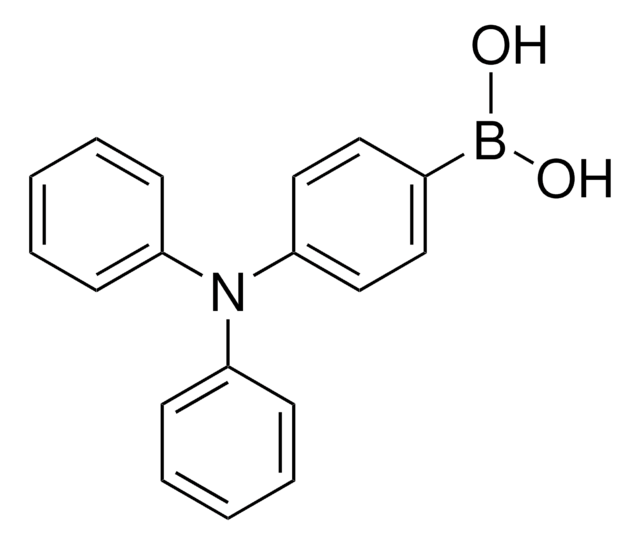929476
N-Acetyl-S-(2-amino-9-(4-fluorobenzyl)-6-oxo-6,9-dihydro-1H-purin-8-yl)-L-cysteine
≥95%
Sinónimos:
p-Fluorobenzylguanine ligand, AUTAC ligand, FBnG
Iniciar sesiónpara Ver la Fijación de precios por contrato y de la organización
About This Item
Fórmula empírica (notación de Hill):
C17H17FN6O4S
Número de CAS:
Peso molecular:
420.42
Número MDL:
Código UNSPSC:
12352209
NACRES:
NA.21
Productos recomendados
Nivel de calidad
Análisis
≥95%
formulario
powder or chunks
idoneidad de la reacción
reagent type: ligand
temp. de almacenamiento
2-8°C
cadena SMILES
O=C1NC(N)=NC2=C1N=C(SC[C@@H](C(O)=O)NC(C)=O)N2CC3=CC=C(C=C3)F
Aplicación
N-acetyl-S-(2-amino-9-(4-fluorobenzyl)-6-oxo-6,9-dihydro-1H-purin-8-yl)-L-cysteine is a p-fluorobenzylguanine (FBnG) based ligand used to initiate selective autophagy as a strategy for targeted protein degradation and PROTAC (proteolysis-targeting chimeras) technology.
Related Technology Spotlight: Degrader Building Blocks for Targeted Protein Degradation
Browse our growing synthesis and research tools: Protein Degrader Building Blocks
Related Technology Spotlight: Degrader Building Blocks for Targeted Protein Degradation
Browse our growing synthesis and research tools: Protein Degrader Building Blocks
Otras notas
AUTACs: Cargo-Specific Degraders Using Selective Autophagy
Iterative Design and Optimization of Initially Inactive Proteolysis Targeting Chimeras (PROTACs) Identify VZ185 as a Potent, Fast, and Selective von Hippel-Lindau (VHL) Based Dual Degrader Probe of BRD9 and BRD7
BAF complex vulnerabilities in cancer demonstrated via structure-based PROTAC design
Cereblon versus VHL: Hijacking E3 ligases against each other using PROTACs
Systematic exploration of different E3 ubiquitin ligases: an approach towards potent and selective CDK6 degraders
Iterative Design and Optimization of Initially Inactive Proteolysis Targeting Chimeras (PROTACs) Identify VZ185 as a Potent, Fast, and Selective von Hippel-Lindau (VHL) Based Dual Degrader Probe of BRD9 and BRD7
BAF complex vulnerabilities in cancer demonstrated via structure-based PROTAC design
Cereblon versus VHL: Hijacking E3 ligases against each other using PROTACs
Systematic exploration of different E3 ubiquitin ligases: an approach towards potent and selective CDK6 degraders
Información legal
PROTAC is a registered trademark of Arvinas Operations, Inc., and is used under license
Producto relacionado
Referencia del producto
Descripción
Precios
Código de clase de almacenamiento
11 - Combustible Solids
Clase de riesgo para el agua (WGK)
WGK 3
Punto de inflamabilidad (°F)
Not applicable
Punto de inflamabilidad (°C)
Not applicable
Certificados de análisis (COA)
Busque Certificados de análisis (COA) introduciendo el número de lote del producto. Los números de lote se encuentran en la etiqueta del producto después de las palabras «Lot» o «Batch»
¿Ya tiene este producto?
Encuentre la documentación para los productos que ha comprado recientemente en la Biblioteca de documentos.
William Farnaby et al.
Nature chemical biology, 15(7), 672-680 (2019-06-11)
Targeting subunits of BAF/PBAF chromatin remodeling complexes has been proposed as an approach to exploit cancer vulnerabilities. Here, we develop proteolysis targeting chimera (PROTAC) degraders of the BAF ATPase subunits SMARCA2 and SMARCA4 using a bromodomain ligand and recruitment of
Miriam Girardini et al.
Bioorganic & medicinal chemistry, 27(12), 2466-2479 (2019-03-04)
The von Hippel-Lindau (VHL) and cereblon (CRBN) proteins are substrate recognition subunits of two ubiquitously expressed and biologically important Cullin RING E3 ubiquitin ligase complexes. VHL and CRBN are also the two most popular E3 ligases being recruited by bifunctional
Christian Steinebach et al.
Chemical science, 11(13), 3474-3486 (2020-11-03)
Cyclin-dependent kinase 6 (CDK6) is an important regulator of the cell cycle. Together with CDK4, it phosphorylates and inactivates retinoblastoma (Rb) protein. In tumour cells, CDK6 is frequently upregulated and CDK4/6 kinase inhibitors like palbociclib possess high activity in breast
Daiki Takahashi et al.
Molecular cell, 76(5), 797-810 (2019-10-14)
Protein silencing represents an essential tool in biomedical research. Targeted protein degradation (TPD) strategies exemplified by PROTACs are rapidly emerging as modalities in drug discovery. However, the scope of current TPD techniques is limited because many intracellular materials are not
Vittoria Zoppi et al.
Journal of medicinal chemistry, 62(2), 699-726 (2018-12-13)
Developing PROTACs to redirect the ubiquitination activity of E3 ligases and potently degrade a target protein within cells can be a lengthy and unpredictable process, and it remains unclear whether any combination of E3 and target might be productive for
Nuestro equipo de científicos tiene experiencia en todas las áreas de investigación: Ciencias de la vida, Ciencia de los materiales, Síntesis química, Cromatografía, Analítica y muchas otras.
Póngase en contacto con el Servicio técnico








